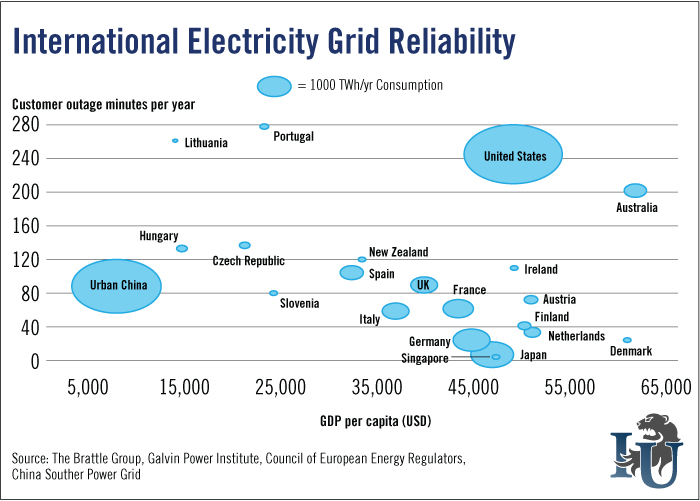
Not only does the U.S. suffer more blackouts than any other developed nation... The number of U.S. power outages lasting more than an hour has increased steadily for the past decade. That’s according to federal databases at the Department of Energy (DOE) and the North American Electric Reliability Corp. (NERC).
Those outages cost about $500 for every man, woman and child in America. That adds up to an estimated $150 billion per year, according to the DOE.
In fact, the U.S. power grid is surprisingly unreliable at the best of times, especially when compared to those of other developed countries.
As you can see in the chart above, the U.S. power grid has by far the most customer outage minutes per year for its economic size.
While people in Japan lose power for an average of four minutes per year, residents of the upper American Midwest lose power for an average of 92 minutes per year. The worst is in the upper Northwest. There, people lose power for an average of 214 minutes per year.
Is it getting worse? Yes! Here are the hard numbers: According to federal data, the U.S. electric grid loses power 285% more often now than in 1984. That’s when data on blackouts was first collected.
The good news is America’s utility industry is moving toward updating its infrastructure into a “smart grid.” This would allow utilities to monitor customers’ electricity use remotely, from a central location, rather than requiring on-site monitoring from gauges or meters at homes and businesses.
A smart grid lets operators calibrate energy supply and use it with precision. A smart grid could reduce costs of power outages by about $49 billion per year.
The bad news? This makeover won’t be cheap. It’ll cost between $338 billion and $476 billion, according to the Electric Power Research Institute.
On the bright side - for investors, at least - much of that money will go to a handful of publicly traded tech companies.
